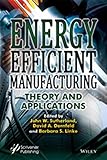Energy efficient manufacturing : theory and applications / edited by John W. Sutherland, David A. Dornfeld and Barbara S. Linke.
Contributor(s): Sutherland, John W. (John William) [editor.] | Dornfeld, D. A [editor.]
| Dornfeld, D. A [editor.] | Linke, Barbara S [editor.]
| Linke, Barbara S [editor.] .
.
Material type:  BookPublisher: Hoboken, NJ : Beverly, MA : John Wiley & Sons ; Scrivener Publishing, 2018Description: 1 online resource.Content type: text Media type: computer Carrier type: online resourceISBN: 9781119519812; 1119519810; 9781119519904; 111951990X.Subject(s): Manufacturing processes -- Energy conservation
BookPublisher: Hoboken, NJ : Beverly, MA : John Wiley & Sons ; Scrivener Publishing, 2018Description: 1 online resource.Content type: text Media type: computer Carrier type: online resourceISBN: 9781119519812; 1119519810; 9781119519904; 111951990X.Subject(s): Manufacturing processes -- Energy conservationIncludes index.
Print version record and CIP data provided by publisher (viewed on October 9, 2018).
Cover -- Title Page -- Copyright Page -- Dedication -- Contents -- 1 Introduction to Energy Efficient Manufacturing -- 1.1 Energy Use Implications -- 1.2 Drivers and Solutions for Energy Efficiency -- References -- 2 Operation Planning & Monitoring -- 2.1 Unit Manufacturing Processes -- 2.2 Life Cycle Inventory (LCI) of Unit Manufacturing Process -- 2.3 Energy Consumption in Unit Manufacturing Process -- 2.3.1 Basic Concepts of Energy, Power, and Work -- 2.3.2 Framework of Energy Consumption -- 2.4 Operation Plan Relevance to Energy Consumption -- 2.5 Energy Accounting in Unit Manufacturing Processes
2.6 Processing Energy in Unit Manufacturing Process2.6.1 Cases of Processing Energy Modeling -- 2.6.1.1 Forging -- 2.6.1.2 Orthogonal Cutting -- 2.6.1.3 Grinding -- 2.6.1.4 Specific Energy vs. MRR -- 2.6.2 Energy Measurement -- 2.7 Energy Reduction Opportunities -- 2.7.1 Shortening Process Chain by Hard Machining -- 2.7.2 Substitution of Process Steps -- 2.7.3 Hybrid processes -- 2.7.4 Adaptation of Cooling and Flushing Strategies -- 2.7.5 Remanufacturing -- References -- 3 Materials Processing -- 3.1 Steel -- 3.1.1 Steelmaking Technology -- 3.2 Aluminum -- 3.2.1 Aluminum Alloying -- 3.2.2 History of Aluminum Processing
3.2.3 Aluminum in Commerce3.2.4 Aluminum Processing -- 3.2.5 Bayer Process -- 3.2.6 Preparation of Carbon -- 3.2.7 Hall-Heroult Electrolytic Process -- 3.3 Titanium -- 3.3.1 Titanium Alloying -- 3.3.2 History of Titanium Processing -- 3.3.3 Titanium in Commerce -- 3.3.4 Titanium Processing Methods -- 3.3.5 Sulfate Process -- 3.3.6 Chloride Process -- 3.3.7 Hunter Process and Kroll Process -- 3.3.8 Remelting Processes -- 3.3.9 Emerging Titanium Processing Technologies -- 3.4 Polymers -- 3.4.1 Life Cycle Environmental and Cost Assessment -- 3.4.2 An Application of Polymer-Powder Processes -- References
4 Energy Reduction in Manufacturing via Incremental Forming and Surface Microtexturing4.1 Incremental Forming -- 4.1.1 Conventional Forming Processes -- 4.1.2 Energy Reduction via Incremental Forming -- 4.1.3 Challenges in Incremental Forming -- 4.1.3.1 Toolpath Planning for Enhanced Geometric Accuracy and Process Flexibility -- 4.1.3.2 Formability Prediction and Deformation Mechanics -- 4.1.3.3 Process Innovation and Materials Capability in DSIF -- 4.1.3.4 Future Challenges in Incremental Forming -- 4.2 Surface Microtexturing -- 4.2.1 Energy Based Applications of Surface Microtexturing
4.2.1.1 Microtexturing for Friction Reduction4.2.1.2 Microtexturing Methods -- 4.2.1.3 Future Work in Microtexturing -- 4.3 Summary -- 4.4 Acknowledgement -- References -- 5 An Analysis of Energy Consumption and Energy Efficiency in Material Removal Processes -- 5.1 Overview -- 5.2 Plant and Workstation Levels -- 5.3 Operation Level -- 5.4 Process Optimization for Energy Consumption -- 5.4.1 Plant Level and Workstation Level -- 5.4.2 Operation Level -- 5.4.2.1 Turning Operation -- 5.4.2.2 Milling Operation -- 5.4.2.3 Drilling Operation -- 5.4.2.4 Grinding Operation -- 5.5 Conclusions -- References


There are no comments for this item.